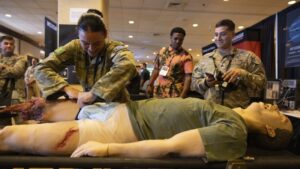
Story by Sgt. 1st Class Timothy Hughes
18th Medical Command
What does it take to win in the complex Indo-Pacific region?
Spanning over 4,000 miles and consisting mostly of the air and maritime domain, as well as densely populated land masses, the Indo-Pacific creates logistical challenges further complicated by the tyranny of distance and time – both of which feed into the calculus of providing sustained health service support for U.S. Troops.
“With 80 percent of the world’s population living in this region – and growing – in some of the most densely populated megacities and pieces of terrain,” said 18th Medical Command Commanding General U.S. Army Maj. Gen. Paula Lodi during a commander’s corner presentation. “If you are into taking care of people – across a range of operations from humanitarian assistance and disaster relief, to large-scale combat, the fact that six out of every 10 people in the world live here is profound.”
Through the lens of U.S. military forces, the tyranny of distance is a challenge presented by the space between the U.S. and China – its military pacing threat in the region.
Additionally, the time it takes to respond to unpredictable disasters including earthquakes, tsunamis, and volcanic eruptions is commonly known as the tyranny of time. All of which have unique dilemmas and problem sets Army Medicine must be able to satisfy when called upon.
“Two pillars of Army Medicine, health service support and force health protection, are certainly key in competition and have unique challenges in crisis – be it man made or natural,” Lodi said.
Army medicine directly and indirectly effects essential elements of whole-of-government successes in the Indo-Pacific. 18th MEDCOM campaigns, has oversight of global health engagements, and experiments to continue to posture for medical readiness of the U.S. Army Pacific and U.S. land Forces throughout the region.
“If you are a warfighter, the theater medical command campaigns through operation pathways and the Joint Pacific Multinational Readiness Center to demonstrate readiness and improve Joint interior lines,” Lodi said. “If you are a partner, we bring the breadth and depth of the Army Medicine enterprise to bear in execution of a comprehensive Global Health Engagement strategy to improve interoperability and positional advantage.
“If you are industry, we leverage Army Futures Command and our Medical Center of Excellence to infuse experimentation into our operations in support of modernization (and) continuous transformation.” she continued.
Campaigning
18th MEDCOM recently demonstrated how it uses exterior lines to build interior lines during Balikatan 24 with its Allies in the Philippines. Its approach was three prong: tactical, operational, and strategic.
“Tactically, clinical subject matter experts conducted shoulder-to-shoulder training with our Armed Forces Philippines Allies strengthening interoperability,” she said. “Operationally, we coordinated and synchronized the deployment of USARPAC’s surgical detachment and [Continental United States] based field hospital and medical logistics capabilities to support high-risk training.
“Strategically, the medical logistics enterprise rehearsed at echelon validating facilities for forward posture, managing shipments from Theater Warehouse in Japan and direct from [Defense Logistics Agency] to the Joint Theater Distribution Center,” Lodi said. “This strategic initiative opened a new commercial corridor demonstrating resilience with redundant lines of communication to reinforce our interior lines.”
Global Health Engagement Strategy
In FY23, the “Pacific Knights” synchronized medical effects of over 200 engagements and was directly responsible for the execution of 15 GHEs by leveraging Operation Pathways.
Lodi said leveraging Pathways for opportunities and deliberately focusing on areas and with partners we don’t access through Pathways was tailored to specific capability gaps and mutually beneficial actions.
The effort was rewarding for relationship building across the Indo-Pacific.
“Output of this effort is understanding of shared challenges, interoperability, and agreements that enable rapid operationalization of capability when necessary.
Experimentation
Challenges in the Indo-Pacific requires U.S. Army Medicine leaders to continue evolving as they keep pace with China.
“To achieve the intent of continuous transformation and meet modernization objectives,” Lodi said, “we must infuse experimentation and modernization efforts whenever possible.”
18th MEDCOM helps inform USARPAC, Army Futures Command, and Army Medicine to modernize the medical force.
“Through a range of initiatives related to blood,” Lodi said, “from research and development of emerging blood products to advanced methods of storage and delivery on the battlefield, telemedicine continues to evolve as a force multiplier.
“From improving access to behavioral health professionals to enabling trauma surgical consultations on the battlefield,” she said, “the future may see surgeons remotely operating far forward robotics performing lifesaving procedures near the Forward Line of Troops.
18th MEDCOM sets the Joint theater for medical operations while increasing its strategic posture by synchronizing and coordinating health service support and medical logistics across its more than 4,000 square mile area of responsibility.